In: Niagara art
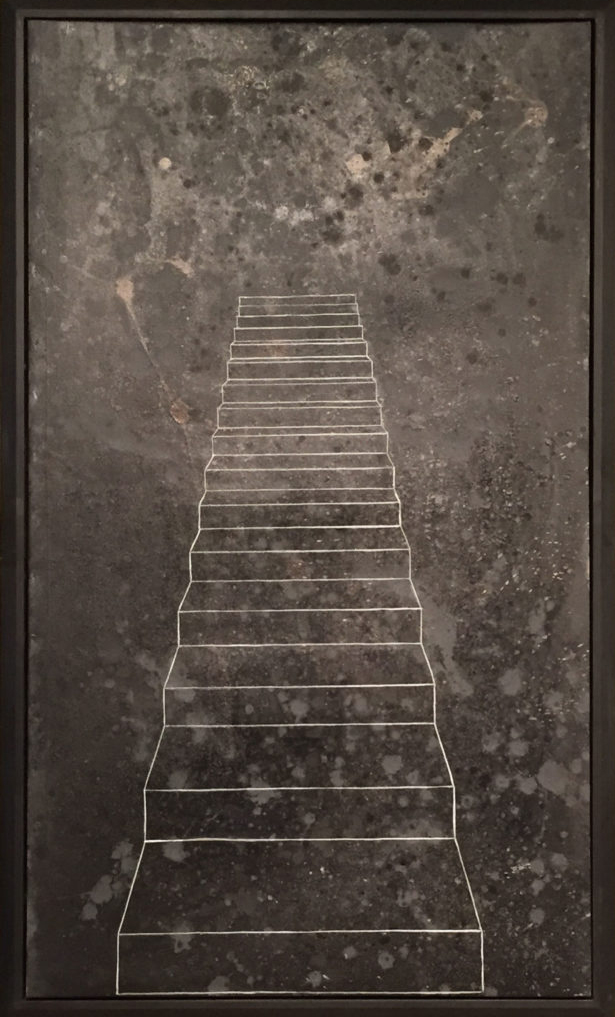
Ron Boaks | Stairway To The Heavens V | 2017
October 20, 2023Ron Boaks | Stairway To The Heavens V | 2017
There is a black which is old and a black which is fresh. Lustrous black and dull black, black in sunlight and black in shadow.
(Ad Reinhardt, from Art-as-art: The Selected Writings of Ad Reinhardt)
The dead cannot remember themselves; that’s why the living have to.
(Sarah Monette)
At the risk of getting too personal, too subjective, it’s often not a good experience to go to an art opening when you’re known in the community as an arts journalist. RM Vaughan has written about this, but there are – of course – exceptions to this rule, stepping outside the space where you have individuals attempting to bully and bleat or blow smoke up your ass, ahem.
When I was spending time in an exhibition of Ron Boaks’ painting a few years ago at a gallery in Niagara, an impromptu conversation with the artist became a high point of interaction and conversation about his work (and the larger milieu of artmaking, too).
At that time, Ron and I spoke about a body of work I colloquially refer to as the ‘Staircase’ series. These are (literally) darker works with an assortment of symbolic or metaphorical glyphs “scratched” and seemingly etched into and upon them : many of the pieces are defined by the recurring – but simple and perfect in execution – staircase. This offers an invitation to another site : not so much an ending as a transition to another place and sense of being.
Our conversation, at some point, touched upon how these were scenes Ron had created in response to the loss of loved ones : and I should clarify that they were dark in a formal sense but not in an experiential one. They had an element of hope, an injection of transcendence, perhaps, instead of a commentary on endings.
This painting that I’m featuring is from that exhibition and grouping of artworks : Boak’s Spirit Arise series.
Boaks’ words : “With this body of work, I am trying to capture “the lightness of being”, that essence of life, state of grace, of being alive right now. In 2013 two very dear people to me died. Awhile after their passing, I began to feel lighter in “spirit”, as, if they were now free, that it was OK for me to feel that too. This lightness is translated into these paintings as the energy or spirit entity, surrounded by rich colour. The paintings are grounded by the almost drafted line, measured, as it were, like distance markers on a map. X and Y coordinates are usually there, doubling as chromosomes. There are collaged bits, often as the pieces on each side edge that mark my boundaries. Balance and the interplay of opposites is as important as ever. Some of these paintings are serene and sublime while others are happy in their intensity or darkness. These are complex relationships made visible as simply as possible. These works need to be mulled over, absorbed and enjoyed.”
I would later visit Ron’s studio and we chatted about his work : I always love when artists trust me enough to invite me into their spaces, and I think that initial conversation had a role in that.
This is an image that offers a sense of what comes after death (and I say this as someone who is between an agnostic and an atheist, most days): but that which we leave behind us exists in a variety of forms, whether our experiences with others or the impressions we leave upon them, that inspire those whom remain to commemorate our passing.
Ronald Boaks’ career as an artist spans 30 + years. He has exhibited throughout Canada, the United States and the United Kingdom. His artwork has been widely collected and can be found in many public, corporate and private collections nationally and internationally.
More about his work can be seen here (Boaks was a previously featured Artist You Need To Know from AIH Studios’ continuing series) and at his site.
~ Bart Gazzola
Read More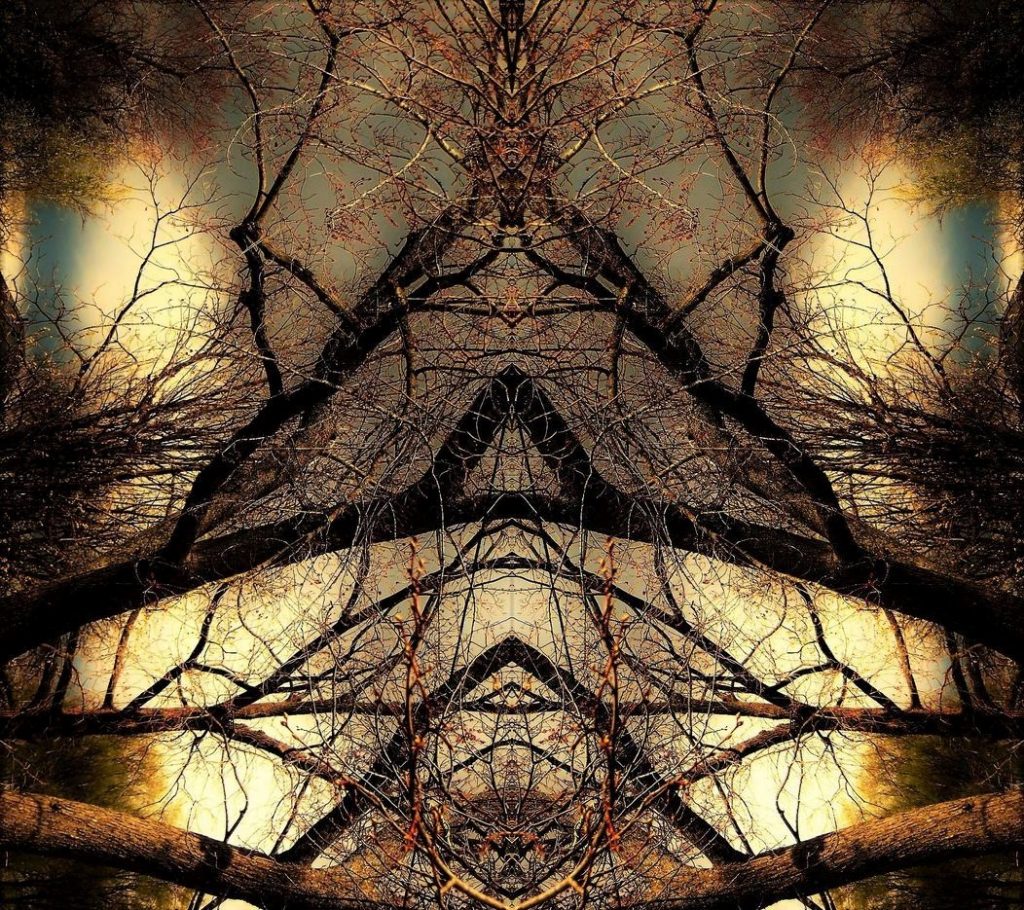
Diane Beard | Walking from the Darkness to the Light
October 2, 2023Diane Beard | Walking from the Darkness to the Light
“…life is brief and lovely, not long and foolish, that it is strange and beautiful, yeah as a dream, then so let it be, if it must be tears, if tears alone may serve…”
(Jack Kerouac)
Diane Beard is a photographer who takes pictures of her immediate community of Welland (usually while walking the streets of the city), often manipulating the images digitally to have a surreal or abstracted quality.
She was one of the featured artists in the Welland Creatives Network’ 13 on the 13th exhibition at the Welland Historical Museum in 2022. We became acquainted during COVID, when the artists’ group I facilitate – the 5 x 2 Visual Conversations – began to ‘meet’ online, and Beard was an enthusiastic and impressive participant.
Diane is the widow of artist Ross Beard (1953 – 2019) who was arguably the most significant visual artist in the history of the city of Welland. Frankly, I prefer to say ‘is’ as a recent exhibition of his work indicated that he lives on in his artwork and the joy many find within it.
His passing was – is – a fracture in her life, and part of her response has been the many images she’s produced and shared, both online and in the Niagara visual arts community.
From a recent exhibition – which was titled Walking from the Darkness to the Light – in St. Catharines : “Having been surrounded by Ross’s awe-inspiring art, sharing the same love of nature and appreciation for the Niagara area, driven by grief combined with a loss of identity after Ross’s passing, yet with no formal training, Diane began taking photographs as means to express her feelings and emotions. Diane’s sense of color and form transcends a simple mundane scene into something abstract and at times unrecognizable mimicking the profound change in her life.”
I’ve been lucky enough to talk with Diane often about her work. The contrast between a scene you recognize and something completely alien is one of the aspects of her work that’s alluring. Beard has an innate sense of colour, composition and a vibrancy in her scenes. This vivacity is an appropriate challenge to the fact that these images are, at their genesis, about loss and mourning and how to move through that….
Beard shares images regularly on social media, and is a prolific artist. I’ve only shared a small part of her body of work, and more can be enjoyed here and here.
~ Bart Gazzola
Read More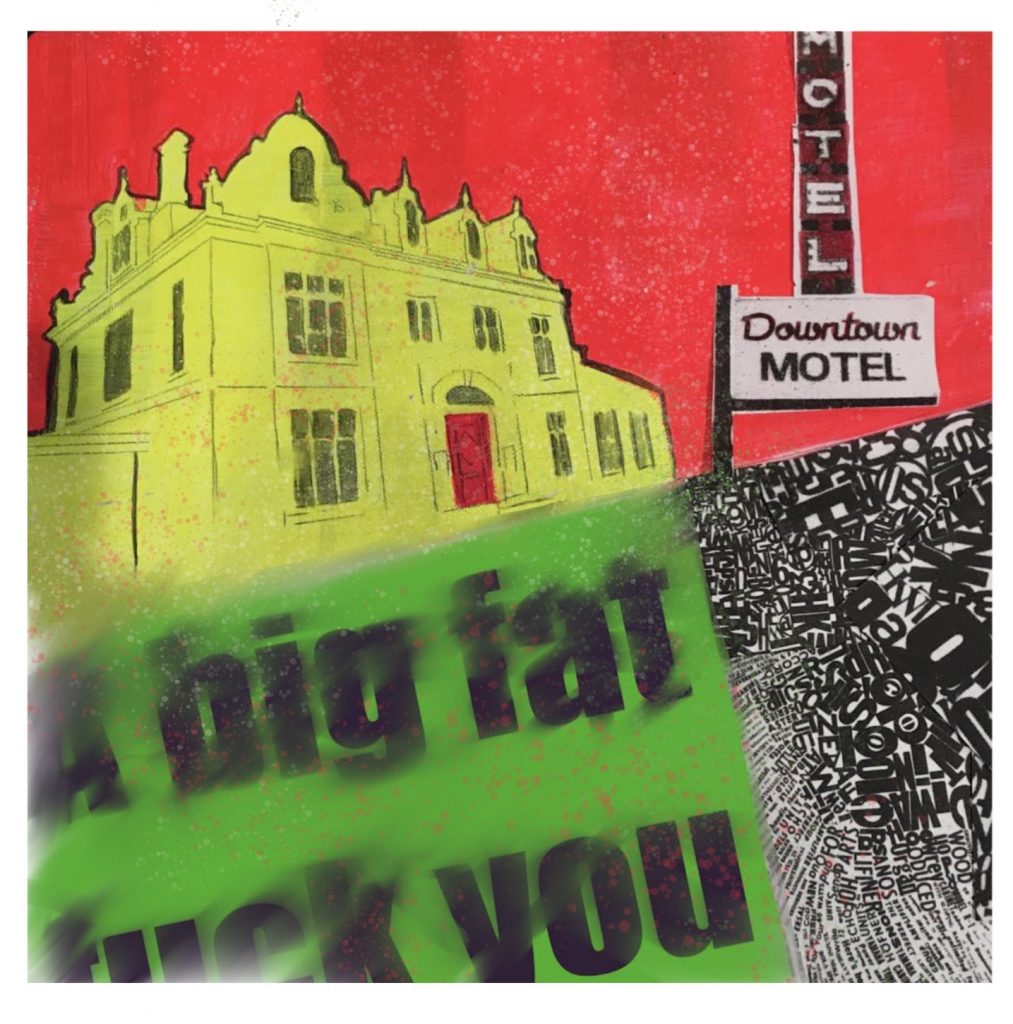
Liz Hayden | I dare you | 2022
September 24, 2023Liz Hayden | I dare you | 2022
“…the City’s refusal to support a public art gallery makes it’s endorsement of a heritage award a travesty.”
(Elizabeth Chitty)
A decade or so ago, I curated an exhibition from the archives of the now defunct (having merged into paved arts) Photographers Gallery in Saskatoon. On the accompanying panel (with artists Patrick Close, Sandra Semchuck and Doug Townsend, whom all had played seminal roles with the gallery as well as organizations like CARFAC and the Saskatchewan Arts Board) I made the observation that communities will create images of themselves that more accurately reflect the reality of the place, often when confronted with depictions that are not just disconnected from lived experience but in direct opposition to reality.
Liz Hayden’s image has been in my mind since she first shared it on social media some time ago : Hayden has been a vocal ally during the travails here in calling out the lies and self aggrandizing ignorance that has defined Brock University’s ‘demolition through neglect’ (to quote a past Cultural Coordinator for the city of St. Catharines) and sale of Rodman Hall Arts Centre, and the City of St. Catharines’ weathervaning between apathy and self congratulatory dishonesty.
The latest chapter in the travesty that is the City of St. Catharines’ apathy and ignorance – which has, in that manner I should know better by now, become even more egregiously foolish – was brought to my attention earlier this week. You can read more about that here. Essentially, the city council of St. Catharines – which I sometimes less than affectionately refer to as ‘North Welland’, to remind them that the delusion that STC is the ‘jewel’ of Niagara is a transparent lie to many of us in the cultural milieu – is seeking provincial heritage designation for the former gallery site, though it’s nothing more than a boutique hotel now, and all the things that made it an important site are now lost…
This is nothing more than STC Council giving an award to someone who has helped the local political cowards, miscreants, liars and ignorant incompetents NOT have to deal with the fact that the gallery may have been bulldozed and the subsequent critiques that would then expose their absence on the loss of the gallery and the harm this caused to the cultural community.
We used to have a nationally recognized and lauded art gallery, a centre for cultural and community oriented groups and now it’s just a ’boutique hotel’ and this merits recognition? This is an affront, especially considering the lackadaisical disinterest of the previous mayor and the inaction of many supposed ‘stakeholders.’
Did I mention that the city of St. Catharines has made some rumblings about wanting to have a ‘cultural renaissance’ in the city? Some things I cannot make up.
But now that I have set the stage with that intersecting rant, let us consider Liz Hayden’s artwork that speaks to these ideas. When we were speaking about it recently, she made the comment of ‘angry colours, wasted words.’
This work by Liz Hayden is titled I dare you : and I suspect that is a title that dares the viewer, but also those whom might be ‘offended’ by what the work states, to attempt to defend what has been allowed to happen, so their ignorance might be exposed. This is – like much of my writing and advocacy on the subject – perhps tilting at windmills : a recent ‘conversation’ on the Niagara History social media page was rife with people ‘excited’ at the new hotel, ignoring that access to the grounds would be limited, that a community focal point was gone, that citizens were irrelevant next to a few consumers and that this is a superficial facade that is a shoddy cover for what was an award winning artistic space that was deeply important to many.
These are some of the words that Hayden included to accompany another work in this series (which can be seen in the full post), but they are relevant here, as well :
Show me your garden and I shall tell you what you are. (Alfred Austin)
He is the gardener.
There at daybreak, he tills and waters: nurturing the plants, the community. Open-handed, he shares hard-gained knowledge and his harvest. Here is a place to heal, to grow. Free, in the air, without fear.
He is the gardener.
He walks the park, picking up.
Greets the old ladies, and their dogs, by name
A smile, the weather.
The garden is his purpose.
He toils there and grows
Himself and all of us
In that earth
This is one of a series of garden portraits I completed in 2022 focusing on gardens and gardeners here in St. Catharines, the Garden City. This acrylic on canvas portrays Richard Pierpont park, (previously known as Centennial Gardens) and Ross Hayden who has gardened there since the inception of those public gardens approximately 10 years ago.
A garden is a fine metaphor for a community : and there are many who are as insulted by the council’s proposal in terms of the loss of the green space as much as the artistic space. I will admit that I am also reminded of Oscar Wilde’s story about The Selfish Giant, but that one, at least, has a happy ending : but the giant had some introspection and that cannot be said for St. Catharine’s political ‘leaders’, on this front….
~ Bart Gazzola
Read More
Julianna D’Intino | Connecting Rods: A Survey of Industry in the Niagara Region, 2015 – 2022
September 22, 2022Julianna D’Intino | Connecting Rods: A Survey of Industry in the Niagara Region, 2015 – 2022
To talk of the legacy of GM when you live in the city of St. Catharines is akin to how your tongue will always go to the gap in your teeth, seeking something that was there and now is not, leaving nothing behind but a perceptible absence you are unable to ignore.
Julianna D’Intino’s images, both moving and still – and I’ve been lucky enough to see several bodies of work she’s produced – often have a local focus, and in some ways she steps into that role of photographer as social historian. Often this involves her adjacent community in Niagara, exploring her own immediate heritage and circle. One such series can be seen here.
Connecting Rods: A Survey of Industry in the Niagara Region is a family story, as well as a local one. The ‘connection’ in the title of this series is not just a nod to an industrial interpretation, but also the families, communities and city that is part of a network that once had its epicenter in the abandoned wastelands D’Intino presents us with….and in her fine words about this series, D’Intino also draws connections to other areas with similar experience, such as with Atlas Steels or John Deere in Welland.
That potential for ‘nostalgia’ doesn’t mean what D’Intino is telling us is through rose – coloured glasses, nor does it gloss over the reality: her words about this work are as unflinching and honest – and engaging – as her photographs.
“This is but one personal case study in the myriad of lost industry of the Niagara Region. Would the return of the Niagara Region as a manufacturing hub provide a sustainable solution to the region’s economic woes? No, it would not. What is missing in the region is sufficient work at wages high enough to sustain a well-balanced life at the Niagara Region’s new inflated cost of living. The last time that such security was widespread was when manufacturing was a leading industry.”
The legacy of GM in St. Catharines is surely a contested narrative, with ground fertile for those from here – like D’Intino, or myself – to mine. It’s as rife as the industrial damage left behind at the site (an ongoing issue in civic politics here which has led to some grotesque and unsettling bedfellows), and there are differing opinions in play. Anna Szaflarski, for example, offers another perspective on this history here.
D’Intino’s site is here, and more images and D’Intino’s considered words about Connecting Rods can be found here.
~ Bart Gazzola
Read More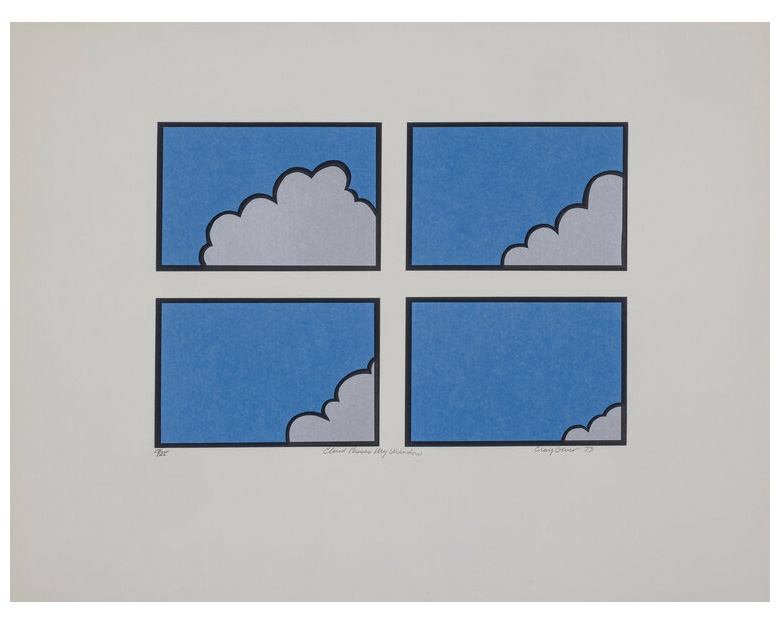
Craig Thomas Oliver | Cloud Passes My Window, 1973
September 15, 2022Craig Thomas Oliver | Cloud Passes My Window, 1973
Craig Thomas Oliver’s work always makes me melancholy. Perhaps it’s because not long after my return to Niagara I was approached to contribute an essay to an upcoming catalogue about the artist, published posthumously, as a means to bring attention to his art and accomplishments in Niagara. Later, I would include him in an exhibition I curated from the collection of Rodman Hall Art Centre, under the title of A Place To Stand, emphasizing artists in that archive who had built a place for others to grow and prosper within St. Catharines and Niagara. Both of those instances strike me as being about moments lost, or passing, with an implicit act of grieving.
Cloud Passes My Window is a small, delicate meditation, with clean, vibrant colours, like a sky so blue it might have been hammered into place. If you’ve visited Niagara Artists Centre (NAC) and their upstairs terrace – the CTO Terrace, named for Oliver, as a founding member of the artist run centre – this motif is familiar to you. On the left wall, a massive reproduction of Oliver’s simple and pristine white cloud on blue dominates the second storey space. It’s an amusing contrast, of the solidity of the architecture and the whimsical, ephemeral clouds, repeated like in this image: but in this work, it slowly leaves us, like any cloud – or person – who was here, and now gone.
I’ve spent many an evening there, with various NAC events, but I always think of it from a clear sunny afternoon, at the end of my first month upon returning to Niagara, in August of 2015. The CTO Terrace is a site often filled with music, so whenever I see any of Oliver’s ‘cloud’ works, Yoko Kanno’s song Blue comes to mind (Never seen a blue sky / Yeah I can feel it reaching out and moving closer
There’s something about blue / Asked myself what it’s all for / You know the funny thing about it / I couldn’t answer / No I couldn’t answer…)
Unsurprisingly, Kanno’s song may be about death, absence and loss, too. I’ve been told my mind goes to dark places, but that’s not entirely true, with the bright blue skies that Oliver shares with us, and that fills a wall in the loft space that bears his name, with ‘his’ sky to the side and the full sky above us…
But a more apropos element of textual ‘collage’ would be from Allen Ginsberg’s Elegy for Neal Cassady, written in the early morning hours (5 – 5:30 AM) upon learning of the passing of his friend and sometime lover:
aethereal Spirit
bright as moving air
blue as city dawn
happy as light released by the Day
over the city’s new buildings –
Lament in dawnlight’s not needed,
the world is released,
desire fulfilled, your history over,
story told, Karma resolved,
prayers completed
vision manifest, new consciousness fulfilled,
spirit returned in a circle,
world left standing empty, buses roaring through streets —
garbage scattered on pavements galore
Upon Oliver’s passing, NAC Director Stephen Remus offered the following tribute: “Craig was a key figure in the first wave of innovative collective projects that set the tone of wit and satire that has endured to define NAC today. [These include] the Niagara Now Billboard Exhibition (1972), Downtown Street Banner Project (1973), The Johnny Canuck Canadian Ego Exposition (1974), and The Johnny Canuck Canadian Ego Exhibitionist (1976). Craig was a master printmaker and he produced print work by many of his fellow NAC artists including John B. Boyle, Dennis Tourbin, Alice Crawley, and John Moffat.”
More about Oliver’s life and artwork can be read here.
~ Bart Gazzola
Read More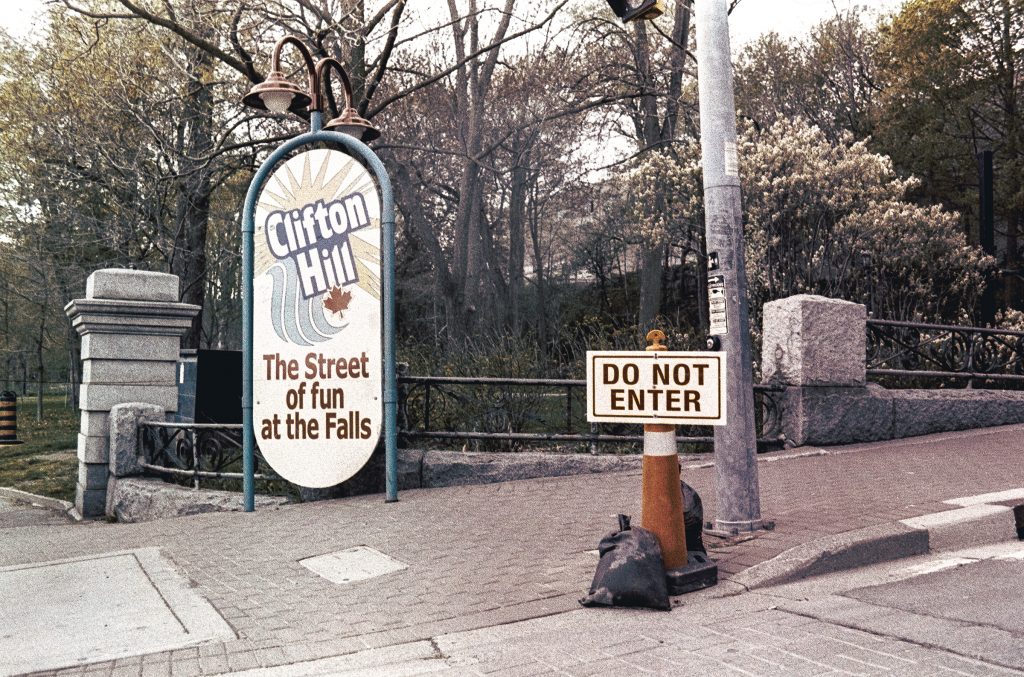
Necropolis | Jon Lepp
May 18, 2022Necropolis | Jon Lepp Necropolis | Jon Lepp, The Open for Business Series @deadendstories Photographs, [Virginia] Woolf claims, "are not an... Read More
Recent Comments